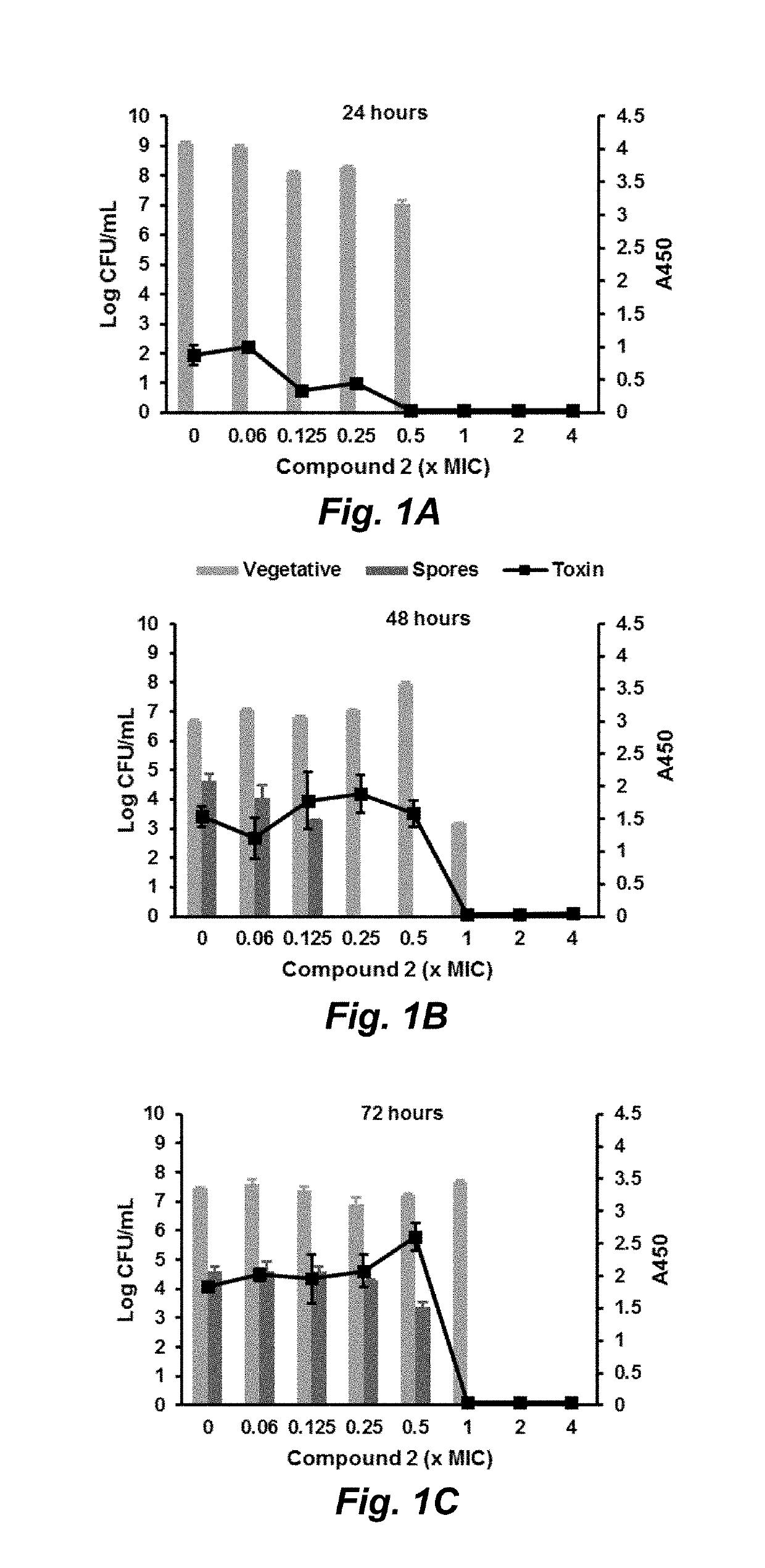Compounds for the treatment of clostridium difficile infection
- Summary
- Abstract
- Description
- Claims
- Application Information
AI Technical Summary
Benefits of technology
Problems solved by technology
Method used
Image
Examples
example 1
Materials and Methods
[0122]Abbreviations. AUC, area under the curve; CDI, C. difficile infection; DMF, dimethylformamide; DMSO, dimethyl sulfoxide; ESI, electrospray ionization; HRMS, high resolution mass spectrometry; ip, intraperitoneal; iv, intravenous; MIC, minimally-inhibitory concentration, MRM, multiple reaction monitoring; MS, mass spectrometry; PK, pharmacokinetic; po, oral; THF, tetrahydrofuran; TLC, thin-layer chromatography; UPLC, ultra-performance liquid chromatography.
[0123]Synthesis. All chemicals, reagents, and solvents were used directly as purchased without further purification. Analytical thin-layer chromatography was performed on silica gel 60 F254. For column chromatography, silica gel 60, 230-400 mesh, 40-63 μm was used. H NMR and 13C NMR spectra were recorded on Bruker AVANCE III HD 500 spectrometers (Bruker Daltonik, Bremen, Germany) and operated at an 1H resonance frequency of 500.13 MHz. Chemical shifts are referenced to the residual deuterated solvent (e.g...
example 2
Pharmaceutical Dosage Forms
[0147]The following formulations illustrate representative pharmaceutical dosage forms that may be used for the therapeutic or prophylactic administration of a compound of a formula described herein, a compound specifically disclosed herein, or a pharmaceutically acceptable salt or solvate thereof (hereinafter referred to as ‘Compound X’):
(i) Tablet 1mg / tablet‘Compound X’100.0Lactose77.5Povidone15.0Croscarmellose sodium12.0Microcrystalline cellulose92.5Magnesium stearate3.0300.0
(iii) Tablet 2mg / tablet‘Compound X’20.0Microcrystalline cellulose410.0Starch50.0Sodium starch glycolate15.0Magnesium stearate5.0500.0
(iii) Capsulemg / capsule‘Compound X’10.0Colloidal silicon dioxide1.5Lactose465.5Pregelatinized starch120.0Magnesium stearate3.0600.0
(iv) Injection 1 (1 mg / mL)mg / mL‘Compound X’ (free acid form)1.0Dibasic sodium phosphate12.0Monobasic sodium phosphate0.7Sodium chloride4.51.0N Sodium hydroxide solutionq.s.(pH adjustment to 7.0-7.5)Water for injectionq.s. a...
PUM
| Property | Measurement | Unit |
|---|---|---|
| Fraction | aaaaa | aaaaa |
| Fraction | aaaaa | aaaaa |
| Fraction | aaaaa | aaaaa |
Abstract
Description
Claims
Application Information
 Login to View More
Login to View More - R&D
- Intellectual Property
- Life Sciences
- Materials
- Tech Scout
- Unparalleled Data Quality
- Higher Quality Content
- 60% Fewer Hallucinations
Browse by: Latest US Patents, China's latest patents, Technical Efficacy Thesaurus, Application Domain, Technology Topic, Popular Technical Reports.
© 2025 PatSnap. All rights reserved.Legal|Privacy policy|Modern Slavery Act Transparency Statement|Sitemap|About US| Contact US: help@patsnap.com



